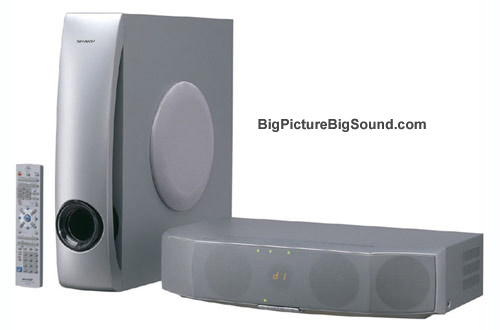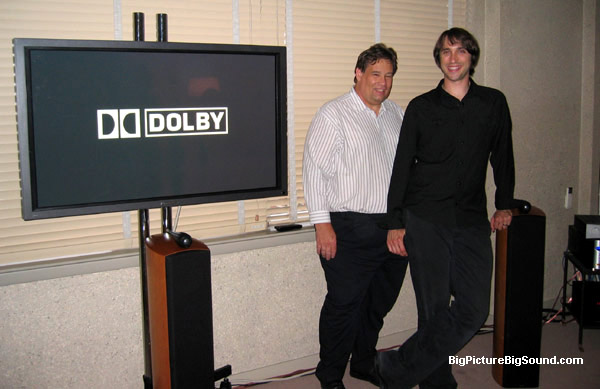Dolby Brings High Quality Surround Sound to the Masses
By Chris Boylan
Dolby Labs, pioneer in noise reduction and high quality digital sound encoder/decoder (codec) technologies, recently came to New York to showcase their latest advancements in entry-level and high-end surround sound. Many people know Dolby as the noise reduction system on their cassette decks or as the audio component of DVDs - Dolby Digital surround sound is the most widely used, and the only mandatory codec on the DVD format - but it's also the surround format of choice for broadcast HDTV in the U.S., as well as a mandatory part of the high definition Blu-ray Disc and HD-DVD specifications.
Dolby is also involved in developing technology that enables end-users to get a believable and enveloping surround sound experience in places they might not expect - like single-box powered speaker systems and even headphones. These systems, as well as a high-end demo of Dolby's TrueHD, comprised the Dolby Surround whirlwind tour that I was privy to last month in New York.
First off was a demo of Dolby Digital Plus on Universal's "Serenity" HD-DVD. Craig Eggers, Senior Manager of Dolby's consumer electronics division, describes Dolby Digital Plus as "Dolby Digital, with the handcuffs off." DD+ is capable of up to 13.1 discrete audio channels and a bit rate of over 6 MBPS (megabits per second), but in the HD-DVD format, it's capped at 7.1 channels at a data rate of 3 MBPS - still a very generous number. Compare this to standard Dolby Digital's theoretical maximum of 640 KBPS (kilobits per second) and the actual DVD limit of 448 KBPS, and you'll begin to see why people are getting excited about Dolby Digital Plus. An HD-DVD which includes Dolby Digital Plus can have up to seven times more data bandwidth allocated to audio. And in the lossy perceptual codec world, bandwidth is king - higher data rates mean more accurate reproduction of music and movies.
Universal's HD-DVD mastering engineers decided on a 5.1-channel 1.5 MBPS Dolby Digital soundtrack for the "Serenity" HD-DVD. The end result, played on Toshiba's HD-XA1 HD-DVD player, through a Denon receiver and into a modestly priced Atlantic Technology speaker system, presented a punchy and enjoyable audio experience. Dialog was clearly articulated, and explosions, gunfire, effects and music came through cleanly, with excellent dynamics.
Dolby followed that demo up with a Blu-ray Disc snippet from "The Fifth Element." I was so distracted by finally seeing the Fifth Element in glorious high definition that I didn't even notice that they had switched the audio over from a $2000+ discrete 5.1-channel surround sound system to a $350 one-box "Virtual Surround" system (OK, technically it was two boxes - one for the subwoofer). Providing "surround" duties in this portion of the demo was the Sharp SD-SP10 system ($350) which includes amplifiers and 5-channel virtual surround drivers in one-box, plus a separate subwoofer which can be placed on the floor and out of sight.
The Sharp system features Dolby's "Virtual Speaker" processing as well as their new "Audistry by Dolby" surround technology, which allows you to dial in the amount of surround effect that sounds best to you. I've heard several one-box simulated surround systems, and this one did a great job of presenting the illusion of surround sound, without having to run wires or speakers to the back of the room.

Sharp's SD-SP10 is the first to include "Audistry by Dolby" processing for a convincing illusion of surround from a single speaker.
Dolby then demonstrated a Dolby Headphone system, using a Pioneer wireless headphone system with Dolby Headphone processing. This wasn't as convincing in presenting the illusion of surround sound for me. But using my reference Etymotic ER4P in-ear 'phones at home, Dolby's online demos of Dolby Surround were pretty impressive. You can check these out yourself using your favorite headphones
here and
here. Dolby Headphone processing is available in outboard boxes that plug and play with your existing home theater. It's also available in small portable units for use with an iPod or portable media player, and it's included in select home theater receivers. Dolby Headphone works in conjunction with Dolby Digital discrete surround sound or with Dolby Pro Logic for matrixed decoding of two-channel audio sources.
The final demo was the "piece de resistance" - a no-holds-barred 5.1-channel audio system comprised of five B&W 805 loudspeakers, a B&W subwoofer and Monster power amplifiers. Content for this demo was hard-drive-based playback of high definition content recorded with Dolby's "TrueHD" audio encoding. Dolby TrueHD is a lossless codec that currently supports up to eight channels of 24-bit/96 KHz audio (192 KHz sampling rate is available if you use six or fewer channels). Dolby TrueHD is an extensible format that can support even more channels in the future with full backward compatibility with any TrueHD decoder. For those who mourn the passing of the DVD-Audio format, Dolby TrueHD is actually the evolution of that format, based on the same Meridian Lossless Packet (MLP) codec, with enhanced metadata, greater theoretical bandwidth, and more channels.

Dolby's Craig Eggers and Jack Buser geek out with the high-end audio gear used to showcase Dolby TrueHD.
But enough of the techno mumbo-jumbo... how did it sound? In a word? Stunning. With excerpts from the PBS "Legends of Jazz" series, (featuring Chick Corea, Dave Brubeck, Al Jarreau, Robert Cray, David Sanborn and more), it felt like I was listening to the original master tapes - trumpet blared through with a natural timber, upright bass had a solid palpable heft, and drums and cymbals were represented with a natural attack and excellent dynamics (and believe me, I know what drums are supposed to sound like).
I can't wait to hear Dolby TrueHD on more familiar content, both music and movies. Four Warner HD-DVD titles already include Dolby TrueHD 5.1 soundtracks ("Phantom of the Opera," "Training Day," "Constantine," "The Perfect Storm"), but Toshiba's first generation players cannot decode multi-channel TrueHD audio tracks (only stereo) so it's not yet possible for the consumer to enjoy these tracks.
As a mandatory spec of HD-DVD (and an optional spec of Blu-ray Disc), and with hdmi 1.3 now finalized, it's only a matter of time before Dolby TrueHD content (and compatible players and processors) become more widely available. Until then, I'll just have to "suffer through" with the Dolby Digital Plus soundtracks on my growing collection of HD-DVDs.


